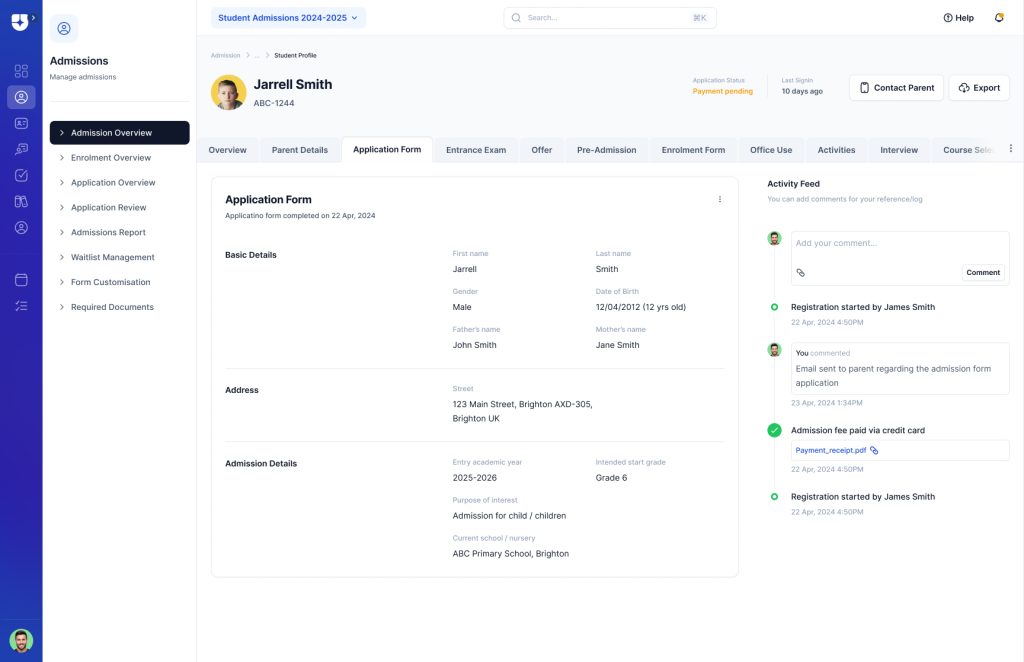Introduction
School management encompasses a range of responsibilities and the need to address various challenges to ensure the smooth operation of educational institutions. Schools encounter numerous challenges in school management that require practical solutions, from monitoring student performance to addressing issues like bullying and cyberbullying. This blog explores five critical challenges in school leadership and provides effective strategies to overcome them.
1. Monitoring student performance
Monitoring student performance is mandatory to identify knowledge gaps and amend knowledge developments. Traditional approaches may not deliver a holistic view of student progress, leading to opportunities for intervention.
Solutions
1.1. Use of data analytics tools
- • School management software: Use analytics-enabled faculty to track student progress, identify learning gaps, and recommend customized exercises.
- • Regular assessments: Conduct regular productive and summative assessments to track student performance and deliver timely feedback.

1.2. Individualized education plans
- • Individualized education programs (IEP): Make IEPs for students who need added support and give personalized education approaches.
- • Adaptive education approaches: Use an adaptive education program that adapts to the student’s education pace and style.

1.3. Involve parents and guardians
- • Parent-educator meetings: Hold regular meetings to discuss student progress and development strategies.
- • Progress reports: Share detailed progress reports to inform and engage parents about their children’s education.
2. Adapting to technological changes
The fast pace of technological development can overwhelm school administration. Effective integration of new technologies into the school system is vital to maintaining competitiveness.
Solutions
2.1. Continuous professional development
- • Training sessions: Organize regular training for educators and staff on new technologies and education tools.
- • Workshops and webinars: Provide access to workshops and webinars to keep teachers streamlined on the latest technology trends.
2.2. Collaboration with technology partners
- • Technology partnerships: Work with technology providers for ongoing support and updates.
- • Pilots programs: Run pilot programs to test new technologies before complete deployment.
2.3. Integrate technology into the course
- • Digital literacy programs: Integrate digital literacy into the course to ensure students are technologically educated.
- • Blended learning model: Use blended learning models that combine traditional education and digital tools.

3. Bullying and cyberbullying
Bullying, including cyberbullying, is a serious problem that affects students’ well-being and academic performance. Solving this requires a holistic approach involving the entire school community.
Solutions
3.1. Implement anti-bullying programs
- • Clear guidelines: Induce clear anti-bullying policies and communicate them to students, staff, and parents.
- • Reporting mechanisms: Induce anonymous reporting systems that allow students to safely report bullying.
3.2. Educate and spread awareness
- • Workshops and webinars: Organize workshops and information webinars about the effects of bullying and cyberbullying.
- • Digital citizenship programs: Educate students about responsible online behavior and the consequences of cyberbullying.

3.3. Support systems
- • Counseling services: Ensure that affected students have access to counseling services.
- • Peer support groups: Start peer support groups to help victims of bullying.

4. Attendance and absence
Regular attendance is essential for academic success. Elevated rates of not being present can hamper student progress and academic success.
Solutions
4.1. Attendance tracking automation
- • Attendance management software: Implement digital management software to directly track student attendance.
- • Real-time announcements: Use software that sends parents real-time announcements about their children’s attendance.
4.2. Communication with students and parents:
- • Regular communication: Regular communication with parents about school attendance and the significance of regular school attendance.
- • Incentive programs: Prompt incentive programs to award students with good attendance rates.

4.3. Identify key issues
- • Identify barricades: Identify and remove barricades to regular participation, such as transportation or health issues.
- • Support programs: Develop support programs for at-risk students to encourage regular attendance.
5. Administrative overload
School administrators frequently have multiple responsibilities that lead to overload. This can lead to inefficiency, miscalculations, and exhaustion.
Solutions
5.1. Reduction of executive tasks
- • School management software: Enable text messaging to automate tasks such as attendance tracking, payment management, and scheduling.
- • Digital records: Move to digital records to reduce paperwork and enhance data access and protection.

5.2. Delegation of tasks
- • Employee empowerment: Delegate administration responsibilities to capable employees to effectively partake in the workload.
- • Committee use: Form committees to perform specific administration tasks, allowing for higher focus and effectiveness.
5.3. Time management strategies
- • Setting task priorities: Use time management tools to prioritize tasks and set realistic deadlines.
- • Professional development: Provide time management and organizational skills training for administrators.
Conclusion
Effective school management requires responding to these general challenges with practical and innovative solutions. Addressing multiple significant challenges is crucial for managing a school to guarantee efficient operations and successful instruction. In order to detect and close learning gaps, schools must constantly assess student performance and modify traditional teaching strategies. It is essential to embrace technological developments, which calls for collaboration with tech providers and continual professional growth.
Bullying—including cyberbullying remains a serious problem that demands the development of extensive bullying prevention initiatives and support networks. For students to succeed in school, consistent attendance is essential, which calls for automated tracking and effective parent-teacher communication.
Additionally, an excess of paperwork may limit productivity, so distributing work to others and employing management tools are essential for reducing stress and enhancing output. If your school is facing challenges in management, our experts are here to guide you on effective strategies to overcome them.

